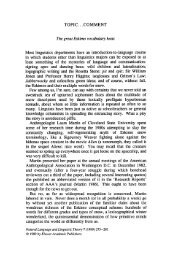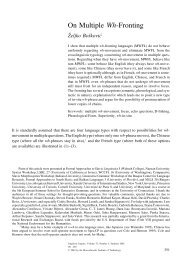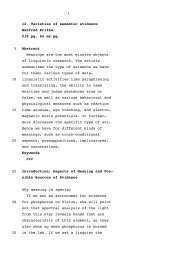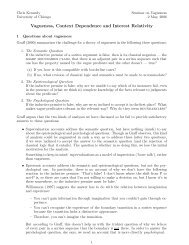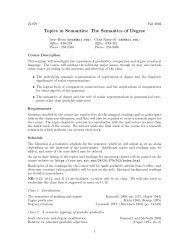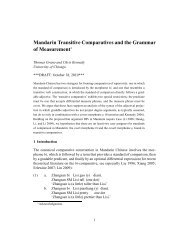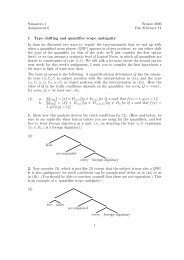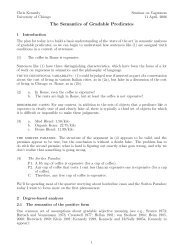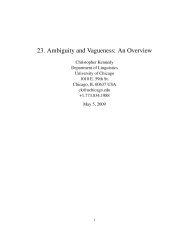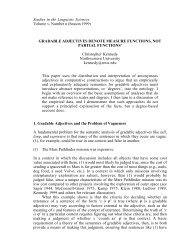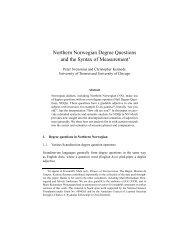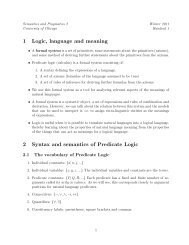On the natural history of negative polarity items - Syntax, Semantics ...
On the natural history of negative polarity items - Syntax, Semantics ...
On the natural history of negative polarity items - Syntax, Semantics ...
Create successful ePaper yourself
Turn your PDF publications into a flip-book with our unique Google optimized e-Paper software.
Gregory Kierstead & Scott Martin<br />
whose length is <strong>the</strong> arity <strong>of</strong> c (written c), and (3) p and q are <strong>the</strong> contributions to <strong>the</strong><br />
root and embedded CGs, respectively. Discourse referents (DRs) are modeled as <strong>natural</strong><br />
numbers (type n): xi is <strong>the</strong> i-th member <strong>of</strong> <strong>the</strong> sequence x.<br />
We give a mostly standard dynamic treatment to <strong>the</strong> intransitive verb tumahol, nominative<br />
marker si, and proper name Fido:<br />
tumahol = def ncx c htrue, bark xni si = def N N fidoi = def D.D i<br />
The dynamic property tumahol (type d = def n ! k) only contributes to <strong>the</strong> embedded<br />
CG, fidoi is a dynamic generalized quantifier (GQ) that passes <strong>the</strong> DR i to a dynamic<br />
property (suppressing here <strong>the</strong> requirement that <strong>the</strong> root CG entails that xi is Fido), and<br />
<strong>the</strong> nominative marker si is semantically <strong>the</strong> identity function. We model daw to both<br />
take scope and have its reportative implication project:<br />
dawS = def QDcxc hrt (QDcx), report (em (QDcx))i<br />
dawP = def QDcxc hrt (QDcx) and report (em (QDcx)), em (QDcx)i<br />
where rt and em give <strong>the</strong> root and embedded CG, respectively. Both daws arepolymorphically<br />
typed: ei<strong>the</strong>r Q is a dynamic GQ and D adynamicproperty,orelseQis a<br />
unary property <strong>of</strong> pro ered contents and D aproered content. The scoping dawS passes<br />
through <strong>the</strong> root CG given by its arguments, and contributes to <strong>the</strong> embedded CG <strong>the</strong><br />
proposition that <strong>the</strong>ir embedded CG contributions were reported. The projective dawP<br />
contributes <strong>the</strong> report to <strong>the</strong> root context, while passing through both CGs contributed<br />
by its arguments. The modal baka passes through its argument’s root CG, contributing<br />
<strong>the</strong> proposition that its argument’s embedded CG contribution is possible:<br />
baka = def kcxc hrt (kcx), maybe (em (kcx))i<br />
These lexical entries allow <strong>the</strong> three readings for daw in (2) to be derived:<br />
baka dawP (si fidoi) tumahol ⌘ cxc hreport (bark xi), maybe (bark xi)i (P)<br />
baka dawS (si fidoi) tumahol ⌘ cxc htrue, maybe (report (bark xi))i (NS)<br />
dawS baka (si fidoi) tumahol ⌘ cxc htrue, report (maybe (bark xi))i (WS)<br />
In <strong>the</strong> (P) reading, <strong>the</strong> implication that maybe Fido barked is contributed to <strong>the</strong> embedded<br />
CG, and <strong>the</strong> report <strong>of</strong> his barking to <strong>the</strong> root CG. The o<strong>the</strong>r two readings leave <strong>the</strong><br />
root CG untouched, yielding <strong>the</strong> two possible scopings <strong>of</strong> dawS with respect to baka.<br />
In sum, this work makes both an important empirical contribution and an important<br />
<strong>the</strong>oretical one. Our fieldwork has produced new data showing that daw is <strong>the</strong> first<br />
known instance <strong>of</strong> an evidential that can both project and take scope beneath o<strong>the</strong>r operators.<br />
Our novel formal analysis preserves desirable attributes from Heim, contributing<br />
compositionality and <strong>the</strong> ability to capture <strong>the</strong> behavior <strong>of</strong> CIs in addition to anaphora<br />
and presuppositions. Most importantly, our framework is <strong>the</strong> first we are aware <strong>of</strong> that<br />
is capable <strong>of</strong> accounting for <strong>the</strong> hybrid status we observe for daw in our empirical work,<br />
fur<strong>the</strong>r contributing to <strong>the</strong> understanding <strong>of</strong> non-presuppositional projective meaning.<br />
Selected References: P. Amaral, C. Roberts, and E. A. Smith. Review <strong>of</strong> The<br />
Logic <strong>of</strong> Conventional Implicatures by Chris Potts. L&P., 30, 2007. S. AnderBois,<br />
A. Brasoveanu, and R. Henderson. Crossing <strong>the</strong> appositive/at-issue meaning boundary.<br />
SALT 20, 2010. J. A. Harris and C. Potts. Perspective-shifting with appositives and<br />
expressives. L&P., 32, 2009. J. Lee. Evidentiality and its Interaction with Tense: Evidence<br />
from Korean. PhD <strong>the</strong>sis, OSU, 2011. E. McCready and N. Ogata. Evidentiality,<br />
modality and probability. L&P., 30, 2007. M. Schwager. <strong>On</strong> what has been said in Tagalog:<br />
Reportative daw. In Evidence from Evidentials, UBCWPL 28, 2010. M. Simons,<br />
C. Roberts, D. Beaver, and J. Tonhauser. What projects and why. SALT 20, 2010.



